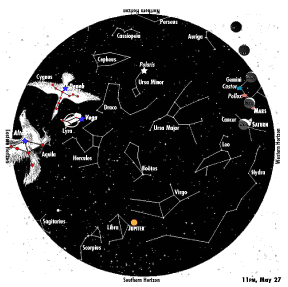|
|
||
|
||
Tales of the TriangleSummer’s most visible stars already shineThe sun continues to rise earlier and set later, by approximately five minutes both at dawn and at dusk. Look for sunrise around 5:45 and sunset around 8:25. The moon wanes to new phase Saturday and reemerges Monday as a slender crescent low in the northwest amid the haze of evening twilight. Shining about 10 degrees above the moon and forming a sharp triangle are the twins of Gemini Castor and Pollux. Tuesday the moon hovers higher three degrees to the north of Mars, and both form a near-straight line extending from Castor and Pollux. Wednesday the moon is higher still, this time less less than three degrees from Saturn. Just as the longer days lead to summer, so do the rising constellations of Lyra, Cygnus and Aquila, the three brightest stars of which form the Summer Triangle. The smallest of the three constellations, Lyra, contains the bright star, Vega. According to Greek myth, the lyre was first crafted by the infant Mercury, who gave it to Apollo, who in turn bestowed it upon his son Orpheus as he embarked with Jason aboard the Argo. With his singing and playing, Orpheus was able to move trees and boulders and to tame all beasts. Cygnus, also called the Northern Cross, is marked by brilliant Deneb. According to one Greek legend, Cygnus was son of Poseidon (in others, the son of Zeus) and had been abandoned at birth on the seashore to die. However, a swan took pity and cared for the newborn. As a grown man, Cygnus defended Troy but was no match for Achilles. Grieving for his son, Poseidon turned him into a swan and placed him in the heavens. Aquila the eagle, marked by Altair, is the bird of Zeus who returns the thunderbolts to his master. Aquila appeared to the young Zeus and urged him to attack the older Titans, thus gaining control of Olympus. |
||
|
|
||
|
© COPYRIGHT 2004 by New Bay Enterprises, Inc. All rights reserved. |




